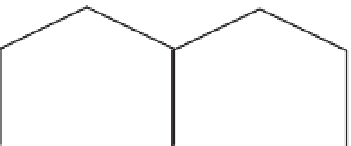Agriculture Reference
In-Depth Information
Area shaded by the gutter
Fig. 3.4.
The shadows of one span on the adjacent span have relevance in multi-span greenhouses
(especially those that are east-west oriented). Shadows are caused by structural elements of the
greenhouse, for instance gutters as well as roofs with a steep pitch.
orientation may be preferable (Castilla, 2001).
In any case, if the priority in a greenhouse is to
achieve the maximum uniformity of radiation
(for instance, in a nursery) the north-south
orientation would be preferable.
Another important aspect to consider
when orienting the greenhouse is the direc-
tion of the predominant winds, which may
become a primary consideration in choos-
ing one or other orientation. The wind has a
strong influence on the structure as a result
of its mechanical effects, and because it has
an indirect influence on the greenhouse
indoor microclimate and energy balance
(see Chapters 7 and 8). The wind increases
the heat losses and the air infiltration leak-
age. Therefore, orientating the ridge parallel
to the direction of the prevailing winds can,
in certain cases, be advisable, but a reduc-
tion of ventilation must be expected.
The characteristics of the building plot
(shape, slope, obstacles that generate shad-
ows) may also limit the greenhouse orienta-
tion options.
because normally they range between 55%
(winter) and 70% (summer), whereas in double-
cover greenhouses they range between 50 and
60% (Baille, 1999). The average reflectivity
(see Chapter 5) of a greenhouse ranges between
20 and 25%, and the absorptivity (see Chapter
5) for both the cover and the structure ranges
from 15% with a simple cover to 25% with a
double cover (Baille, 1999).
At canopy level, the 'radiation satura-
tion level' has been defined as the value
above which the radiation increments do
not involve parallel increases of photosyn-
thesis (see Chapter 6). This situation (widely
studied in laboratory growth chambers) may
occur in greenhouses during the high radia-
tion months at midday, but only on the
leaves located on the upper strata of the
crop, exposed to higher radiation, whereas
the leaves of the lower strata (shadowed by
the upper leaves) receive much less radia-
tion, and are far from the saturation level.
Therefore, considering the plant as a whole,
it is not usual to achieve radiation satura-
tion in species of edible vegetables, even
under Mediterranean conditions (see
Chapter 6), and normally it does not seem
justified to decrease the radiation in the
greenhouse for this reason. It might be nec-
essary, however, to limit radiation for other
3.3.4
Optimization of the transmissivity
Daily transmissivity values above 70% in sim-
ple cover greenhouses are very infrequent,




















